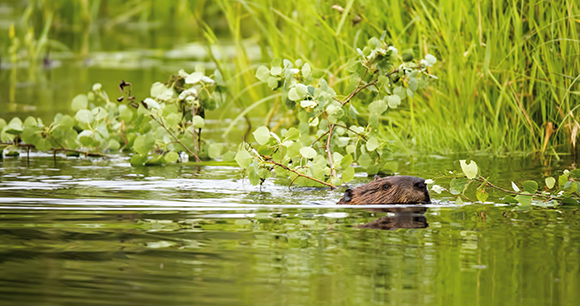
Washington, DC—The Animal Welfare Institute (AWI) applauds U.S. Rep. Suzan DelBene (D-WA) for introducing legislation yesterday that would invest in effective, nonlethal solutions to reduce property damage caused by beavers. The DAMS (Developing Alternative Mitigation Systems) for Beavers Act (H.R. 9501) would establish a federal pilot grant program of $1 million a year for five years to cover the costs of installing and maintaining nonlethal systems in urban and rural areas experiencing human-beaver conflicts.
Once trapped to near extinction for their fur, beavers have recolonized streams throughout the country. Although beavers are often considered to be “nuisance wildlife,” this narrative has shifted significantly in the last few years. They are a particular type of keystone species known as “ecosystem engineers”—their dams create ponds and wetlands that help replenish groundwater, serve as buffers against wildfires, and provide habitat for a wide variety of wildlife. Beavers have even been recognized as partners in the fight against climate change, as their dam-building helps sequester carbon.
Unfortunately, beaver activity can also damage property when they fell trees or build dams that flood nearby roads or agricultural fields, resulting in repair costs for local governments and property owners. As a result, tens of thousands of beavers are trapped, snared, and shot each year across the country, despite the availability of cost-effective, nonlethal, and ecologically beneficial devices that can successfully prevent damage while allowing beavers to thrive.
Mass killing in the name of beaver management is cruel and unnecessary. Beavers are often ambushed with steel-jaw leghold traps that clamp together with bone-breaking force on the animals’ limbs, causing excruciating pain. Beavers are also frequently strangled in neck snares and crushed in body-gripping (Conibear) traps—large, rectangular devices with metal bars designed to slam shut on an animal’s body. Some traps are set specifically to hold beavers underwater until they drown. Because beavers are physiologically adapted to holding their breath for long periods during dives, however, death by drowning can be a slow process.
Alternatively, to promote human-beaver coexistence, trees can be shielded from beavers by encircling them with wire mesh fencing or coating their trunks with a mixture of paint and sand that deters chewing. Roads can be protected from flooding by installing specialized pipes that allow water to flow through dams, thus maintaining acceptable pond levels. AWI has worked to expand the use of these methods throughout the country, garnering support for federal funding for these methods from more than 100 small businesses, wildlife groups, and tribes representing 33 states and the District of Columbia.
"Beavers play a vital role in maintaining healthy ecosystems," said Nancy Blaney, director of government affairs at AWI. “The DAMS for Beavers Act will make an important investment in long-term, nonlethal solutions that will not only benefit beavers but also support communities, promote climate resilience, and protect infrastructure."
Nonlethal measures are not only dependable, but can also be less expensive than lethal control and property repair. A study in Virginia, for example, compared the costs of removing beavers and repairing road damage caused by beavers at 14 sites before and after the use of flow devices. The state transportation department saved hundreds of thousands of dollars per year when nonlethal measures were implemented compared to lethal measures.
To express your support for federal investment in nonlethal methods to solve beaver conflicts, click here.
Marjorie Fishman, Animal Welfare Institute
[email protected], (202) 446-2128
The Animal Welfare Institute (awionline.org) is a nonprofit charitable organization founded in 1951 and dedicated to reducing animal suffering caused by people. AWI engages policymakers, scientists, industry, and the public to achieve better treatment of animals everywhere—in the laboratory, on the farm, in commerce, at home, and in the wild. Follow us on Facebook, Twitter, and Instagram for updates and other important animal protection news.